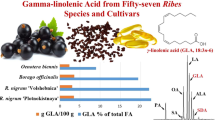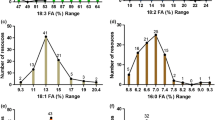Abstract
Nigella sativa L. is an annual underutilized crop of enormous significance, it contains more than 100 bioactive constituents having both pharmaceutical and industrial applications. Nigella sativa L. germplasm consisting of 32 genotypes was quantified for palmitic acid, stearic acid, oleic acid, linoleic and linolenic acid and results obtained varied in percentage. Lipid extracted by chloroform methanol 2:1 (24–37 %) was higher compared to n-hexane (18–35 %) and chloroform methanol 1:3 (18–34 %). Extraction with solvent chloroform methanol 2:1 yielded a higher quantity of oil contents, hence recommended. The polyunsaturated fatty acids were higher than monounsaturated fatty acids. Stearic and palmitic acids were positively correlated as were stearic and linoleic acids. It is inferred that breeding for increased stearic acid, linolenic acid and reduced palmitic acid can be achieved through modern breeding methods. The genotypes rich in oil and oleic-linoleic acid, viz., Pk-020545, Pk-020576, Pk-020609, Pk-020620, Pk-020654, Pk-020699, Pk-020720, Pk-020780, Pk-020874 and Pk-020878, have been suggested for crop improvement programs and could augment the supply of edible oil as well as a biofuel substitute with large scale cultivation.



Similar content being viewed by others
References
Abou-tabl EA, El-Azzouny AA, Hammerschmidt FJ (1986) Aroma volatiles of Nigella sativa L. seeds. In: Brunke E-J (ed) Progress in Essential Oil Research, Walter de Gruyter, Berlin pp 49–55
Merfort I, Wray V, Barakat HH, Hussein MSA, Nawwar MAM, Willuhn G (1997) Flavonoid triglycerides from seeds of Nigella sativa. Phytochemistry 46:359–363
Ustun G, Kent L, Cekin N, Clvelekoglu H (1990) Investigation of the technological properties of Nigella sativa L. (Black cumin) seed oil. JAOCS 67:958–960
Babayan VK, Koottungal D, Halaby GA (1978) Proximate analysis, fatty acid and amino acid composition of Nigella sativa L. seeds. J Food Sci 43:1315–1319
Ramadan MF, Morsel JT (2002) Characterization of phospholipids composition of black cumin (Nigella sativa L.). Nahrung/Food 46(4):240–244
Iqbal MS, Ghafoor A, Qureshi AS, Ahmad Z (2005) Biodiversity and cultivation potential of black cumin (Nigella sativa L.). International symposium “medicinal plants: linkages beyond national boundaries”. In: Shinwari, ZK, Watanaba T, Ali M, Anwar R (eds). National Agricultural Research Centre, Islamabad. Sept. 7–9, 2004. pp 105–116
Atta MB, Imaizumi K (1998) Antioxidant activity of nigella (Nigella sativa L.) seeds extracts. J Jpn Oil Chem Soc 47:475–480
Jacocot B (1995) El aceite de oliva: alimenti medicinal. de aceites y grasas. Oleaginosos 19:149–152
Simon JA, Hodgkins ML, Browner WS et al (1995) Serum fatty acids and the risk of coronary heart disease. Am J Epidemiol 142:469–476
Iqbal MS, Nadeem S, Mehmboob S, Ghafoor A, Rajoka MI, Qureshi AS, Bushra N (2011) Exploring PCR-RAPD markers genotype specific fingerprinting and efficient DNA extraction from black seeds (Nigella sativa L.). Turkish J Agric For 35(6):569–578
Duke JA (1992) Hand Book of phytochemical constituents of GRAS herbs and other economic plants. CRC Press Inc, Florida
Fararh KM, Atoji Y, Shimizu Y, Takewaki T (2002) Isulinotropic properties of Nigella sativa oil in streptozotocin plus nicotinamide diabetic hamster. Res Vet Sci 73:279–282
Hajhashemi V, Ghannadi A, Jafarabadi H (2004) Black cumin seed essential oil, as a potent analgesic and anti-inflammatory drug. Phytother Res 18:195–199
Mashhadian NV, Rakhshandeh H (2005) Antibacterial and antifungal effects of Nigella sativa extracts against S. aureus, P. aeruginosa and C. albicans. Pak J Med Sci 21(1):47–52
Khan N, Sharma S, Sultana S (2003) Nigella sativa (black cumin) ameliorates potassium bromate-induced early events of carcinogenesis diminution of oxidative stress. Hum Exp Toxicol 22:193–203
Kanter M, Meral I, Dede S, Gunduz H, Cemek M, Ozbek H, Uygan I (2003) Effect of Nigella sativa L. and Urtica dioica L. on lipid peroxidation, antioxidant enzyme systems and some liver enzymes in CC14-treated rats. J Vet Med 50:264–268
Fisher C (2002) Spices of life. Chem Br 38:40–42
Nagao A, Yamazaki M (1984) Effect of temperature during maturation on fatty acid composition of sunflower seed. Agri Biol Chem 48:553–555
AOAC (2005) Official methods of analysis. Association of official analytical chemists. 18th Edition, Washington
Folch J, Lees M, Stanley GHS (1957) A simple method for the isolation and purification of total lipids from animal tissues. J Biol Chem 226:497–509
Slover HT, Lanza E (1979) Quantitative analysis of food fatty acids by capillary gas chromatography. J Am Oil Chem Soc 56:933–943
Kaufman L, Rousseeuw PJ (1990) Finding groups in data: an introduction to cluster analysis, Wiley, New York. p 342
Salunkhe DK, Chavan JK, Adsule RN, Kadam SS (1992) World oilseeds: chemistry, technology and utilization. Van Nostrand Reinhold, New York
Mohamed A, Bhardwaj H, Hamama A, Webber C (1995) Chemical composition of Kenaf (Hibiscus cannabinus)L. seed oil. Ind Crops Prod 4(3):157–165
Baldoni E, Bolognani L, Vitaioli L (1995) A rapid procedure for elimination of non-polar lipids hampering the usual polar lipid extraction and TLC separation. Eur J Histochem 253(4):239–257
Sugiyama E, Hara A, Uemura K (1990) A quantitative analysis of serum sulfatide by matrix-assisted laser desorption ionization time-of-flight mass spectrometry with delayed ion extraction. Anal Biochem 90(1):97–274
Boselli E, Velazco V, Caboni MF, Lercker G (2001) Pressurized liquid extraction of lipids for the determination of oxysterols in egg-containing food. J Chromatograph 239(1–2):244–11, 917
Lehninger AL, Nelson DL, Cox MM (2000) Princı´pios de bioquı´mica. Sarvier, Sa˜o Paulo
Ferraz TPL, Fiu´za MC, dos Santos MLA, de Pontes Carvalho L, Soares NM (2004) Comparison of six methods for the extraction of lipids from serum in terms of effectiveness and protein preservation. J Biochem Biophys Methods 58:187–193
Ramadan MF, Morsel JT (2003) Analysis of glycolipids from black cumin (Nigella sativa L.), coriander (Coriandrum sativum L.) and Niger (Guizotia abyssinica Cass.) oil seeds. Food Chem 80:197–204
Firestone D, Mossoba MM (1997) New techniques and applications in lipid analysis. In: McDonald RE, Mossoba MM (Eds). AOCS Press, Champaign, pp 1–33
D’Antuono LF, Moretti A, Lovato AFS (2002) Seed yield, yield components, oil content and essential oil content and composition of Nigella sativa L. and Nigella damascena L. Ind Crops Prod 15:59–69
Ramadan MF, Morsel JT (2004) Oxidative stability of black cumin (Nigella sativa L.), coriander (Coriandrum sativum L.) and niger (Guizotia abyssinica Cass.) crude seed oils upon stripping. Eur J Lipid Sci Technol 106:35–43
Koski A, Psomiadou E, Tsimidou M, Hopia A, Kefalas P, Wahala K et al (2002) Oxidative stability and minor constituents of virgin olive oil and cold pressed rapeseed oil. Eur Food Res Technol 214:294–298
Tasioula-Margari M, Okogeri O (2001) Isolation and characterization of virgin olive oil phenolic compounds by HPLC/UV and GC-MS. J Food Sci 66:530–534
Cheikh-Rouhou S, Besbes S, Hentati B, Blecker C, Deroanne C, Attia H (2007) Nigella sativa L. chemical composition and physicochemical characteristics of lipid fraction. Food Chem 101:673–681
Kanter M, Pemir H, Karakaya C, Ozbek H (2003) Gastroprotective activity of Nigella sativa L oil and its constituent, thymoquinone against acute alcinol–induced gastric mucosal injury in rats. World J Gastroenterol 11:662–666
Iqbal MS, Ghafoor A, Inamullah, Ahmad H (2013) Genetic variation in yield performance for three years in Nigella sativa L. germplasm and its association with morpho-physiological traits and biochemical composition. Pak J Bot 45(6):2065–2070
Al-Bataina BA, Maslat AO, Al-Kofahi MM (2003) Elemental analysis and biological studies on ten oriental spices using XRF and Ames test. J Trace Elem Med Biol 17:85–90
Bruckner G (1992) Biological effects of polyunsaturated fatty acids. In: Chow CK (ed) Fatty acids in foods and their health implications. Marcel Dekker, Inc., New York, pp 631–646
Anonymous (2004) Olive oil nutritional facts. http://www.hormel.com
Jones LA, Kersey JH (2002) Cottonseed article. National Cotton Seed Products Association (NCPA) (USA). http://www.cottonseed.com/publication/csobro.Asp. 12/0/2012
Atta MB (2003) Some characteristics of Nigella (Nigella sativa L.) seed cultivated in Egypt and its lipid profile. Food Chem 83:63–68
Saleh Al-Jassir M (1992) Chemical composition and microflora of black cumin (Nigella sativa L.) seeds growing in Saudi Arabia. Food Chem 45:239–242
Acknowledgments
The authors are grateful to USDA Agricultural Research Service, National Plant Germplasm System, Beltsville, MD, USA for providing seeds of two accessions. Thanks are extended to Mr. Zaheer Ahmad, Oil Testing Lab., for providing lipid standards, and Miss. Syeda Jaffery, Nutrition & Grain Quality Testing Lab., NARC, Islamabad for guidance. The services of Mr. Zubair Ahmad, Third World Center, H.E.J. International Center for Chemical and Biological Sciences, University of Karachi, Karachi, are gratefully acknowledged for performing the GLC. The principal author is extremely thankful to Prof. Dr. David Hildebrand, Department of Plant and Soil Science, College of Agriculture, University of Kentucky, Kentucky for devoting time to critically reviewing the manuscript.
Author information
Authors and Affiliations
Corresponding author
About this article
Cite this article
Iqbal, M.S., Ghafoor, A., Ullah, I. et al. Quantification and Compositional Diversity of Fatty Acid Methyl Esters Profile in Nigella sativa L. Germplasm. J Am Oil Chem Soc 91, 1975–1986 (2014). https://doi.org/10.1007/s11746-014-2535-x
Received:
Revised:
Accepted:
Published:
Issue Date:
DOI: https://doi.org/10.1007/s11746-014-2535-x




